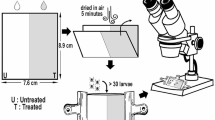Abstract
In Stavropol Territory, ixodid ticks of the genus Dermacentor are represented by three species: D. marginatus, D. reticulatus, and D. niveus. D. marginatus is the most widespread species, constituting 14.8% of all the ticks in the region; D. reticulatus and D. niveus are found less frequently, constituting 2.8% and 0.01%, respectively. D. marginatus and D. reticulatus are spread mostly in the forest-steppe and steppe zones of Stavropol Territory. D. niveus is represented by solitary specimens in arid and semidesert zones. The main hosts of adult D. marginatus in Stavropol Territory are cattle (88.4%) and sheep and goats (5.3%). The hosts of D. reticulatus are also cattle (72.3%) and sheep and goats (4%). D. marginatus activates at an average monthly temperature of +2.07°C and average monthly rainfall of 47.2 mm. The peak of parasitizing on hosts was observed at an average monthly temperature of +7.8°C and average monthly rainfall of 56.2 mm. The autumnal activation was recorded at an average monthly temperature of +15.3°C and average monthly rainfall of 58.2 mm.
Similar content being viewed by others
References
Balashov, Yu.S., Ixodid Ticks—Parasites and Infection Vectors (Nauka, St. Petersburg, 1998) [in Russian].
Beklemishev, V.N., “The Circle of Natural Vectors of Transmissive Diseases Damaging Humans,” Zool. Zh. 34(1), 3–16 (1955).
Beklemishev, V.N., “Terms and Concepts Necessary for the Quantitative Studies of the Population of Ectoparasites and Nidicoles,” Zool. Zh. 40(2), 149–158 (1961).
Belavin, V.S. and Nikolsky, S.N., “Dermacentor marginatus (Olenev, 1931) in the Northern Caucasus,” Trudy Severo-Kavkazskoi Opytnoi Stantsii, Pyatigorsk 1, 69–70 (1937).
Collection, Registration, and Preparation for Laboratory Studies of Bloodsucking Arthropods—Vectors of Agents of Natural Focal Diseases. Methodical Recommendations (MR 3.1.1027-01) Ratified by Chief State Sanitary Officer of Russian Federation in April 6, 2001 (Moscow, 2002) [in Russian].
Hoogstraal, H., African Ixodoidea. 1. Ticks of the Sudan (Department of the Navy Bureau of Medicine and Surgery, Washington, 1956).
Kerbabaev E.B. and Shevkoplyas, V.N., “Two-Year Experience of Monitoring of Ixodid Ticks—Vectors of Cattle Piroplasmoses and Arboviruses in Krasnodar Territory,” in Forum on Hygiene and Sanitary. Research and Practical Conference on Hygiene, Epidemiology, and Disinfectology (Moscow, 2006), p. 190.
Korenberg, E.I., “Infections of the Lime-Borreliosis Group—Ixodid Borrelioses in Russia,” Med. Parazitol. Parazitarn. Bol. 3, 14–18 (1996).
Lutsuk, S.N., Tokhov, Yu.M., and Dyachenko, Yu.V., Ixodid Ticks of Stavropol Territory (Alfaprint, Stavropol, 2012) [in Russian].
Organization and Realization of Measures against Crimean Haemorrhagic Fever in the Territory of Natural Foci in Russia. Guidelines (Moscow, 2001) [in Russian].
Pavlovsky, E.N., Natural Focality of Transmissive Diseases in Relation to Landscape Epidemiology of Zooanthroponoses (Nauka, Moscow, 1964) [in Russian].
Petrishcheva, P.A. and Olsufjev, N.G. (Ed.), Methods of Study of the Natural Foci of Human Diseases (Meditsina, Moscow, 1964) [in Russian].
Pomerantsev, B.I., Ixodid Ticks Ixodidae. Fauna of the USSR. Arachnids, Vol. 4 (2) (Nauka, Leningrad, 1950) [in Russian].
Shpynov, S.N., Samoilenko, I.E., and Rudakov, N.V., “Revealing of Rickettsia of the Group of Tick-Borne Spotty Fever in Territories without Tick-Borne Rickettsiosis Morbidity in European Russia and Southern Urals,” in Actual Problems of Providing Sanitary and Epidemiological Prosperity of the Population of Omsk Province. Materials of Provincial Research and Practical Conference (Omsk, 2000), pp. 215–217.
Tokhov, Yu.M., “Vectors of the Crimean-Congo Haemorrhagic Fever Virus in Stavropol Territory,” Med. Parazitol. Parazitarn. Bol. 4, 32–34 (2005).
Tokhov, Yu.M., Ixodid Ticks of Stavropol Territory and Their Epidemiological Significance (Servisshkola, Stavropol, 2008) [in Russian].
Zahler, M., Gothe, R., and Rinder, H., “Dermacentor Ticks in France and Germany. Molecular Biological Differences in Species, Ecology and Epidemiological Iimplications,” Tierarztl Prax 24(3), 209–211 (1996).
Author information
Authors and Affiliations
Corresponding author
Additional information
Original Russian Text © Yu.M. Tokhov, S.N. Lutsuk, Y.V. Dyachenko, 2013, published in Parazitologiya, 2013, Vol. 47, No. 6, pp. 437–447.
Rights and permissions
About this article
Cite this article
Tokhov, Y.M., Lutsuk, S.N. & Dyachenko, Y.V. Phenology of ixodid ticks of the genus Dermacentor in the Central Ciscaucasia. Entmol. Rev. 94, 426–433 (2014). https://doi.org/10.1134/S0013873814030130
Received:
Published:
Issue Date:
DOI: https://doi.org/10.1134/S0013873814030130




